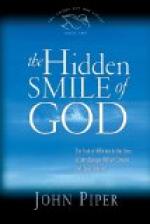marshalled, the style is clear, the language pure
and well chosen. It is, in the main, a well-reasoned
defence of the historical truth of the Articles of
the Creed relating to the Second Person of the Trinity,
against the mystical teaching of the followers of
George Fox, who, by a false spiritualism, sublimated
the whole Gospel narrative into a vehicle for the
representation of truths relating to the inner life
of the believer. No one ever had a firmer grasp
than Bunyan of the spiritual bearing of the facts
of the recorded life of Christ on the souls of men.
But he would not suffer their “subjectivity”—to
adopt modern terms—to destroy their “objectivity.”
If the Son of God was not actually born of the Virgin
Mary, if He did not live in a real human body, and
in that body die, lie in the grave, rise again, and
ascend up into heaven, whence He would return—and
that Bunyan believed shortly—in the same
Body He took of His mortal mother, His preaching was
vain; their faith was vain; they were yet in their
sins. Those who “cried up a Christ within,
in opposition to a Christ without,” who
asserted that Christ had no other Body but the Church,
that the only Crucifixion, rising again, and ascension
of Christ was that
within the believer, and
that every man had, as an inner light, a measure of
Christ’s Spirit within him sufficient to guide
him to salvation, he asserted were “possessed
with a spirit of delusion;” deceived themselves,
they were deceiving others to their eternal ruin.
To the refutation of such fundamental errors, substituting
a mystical for an historical faith, Bunyan’s
little treatise is addressed; and it may be truly
said the work is done effectually. To adopt Coleridge’s
expression concerning Bunyan’s greater and world-famous
work, it is an admirable “
Summa Theologiae
Evangelicae,” which, notwithstanding its
obsolete style and old-fashioned arrangement, may
be read even now with advantage.
Bunyan’s denunciation of the tenets of the Quakers
speedily elicited a reply. This was written
by a certain Edward Burrough, a young man of three
and twenty, fearless, devoted, and ardent in the propagation
of the tenets of his sect. Being subsequently
thrown into Newgate with hundreds of his co-religionists,
at the same time that his former antagonist was imprisoned
in Bedford Gaol, Burrough met the fate Bunyan’s
stronger constitution enabled him to escape; and in
the language of the times, “rotted in prison,”
a victim to the loathsome foulness of his place of
incarceration, in the year of the “Bartholomew
Act,” 1662.
Burrough entitled his reply, “The Gospel of
Peace, contended for in the Spirit of Meekness and
Love against the secret opposition of John Bunyan,
a professed minister in Bedfordshire.”
His opening words, too characteristic of the entire
treatise, display but little of the meekness professed.
“How long, ye crafty fowlers, will ye prey upon
the innocent? How long shall the righteous be




